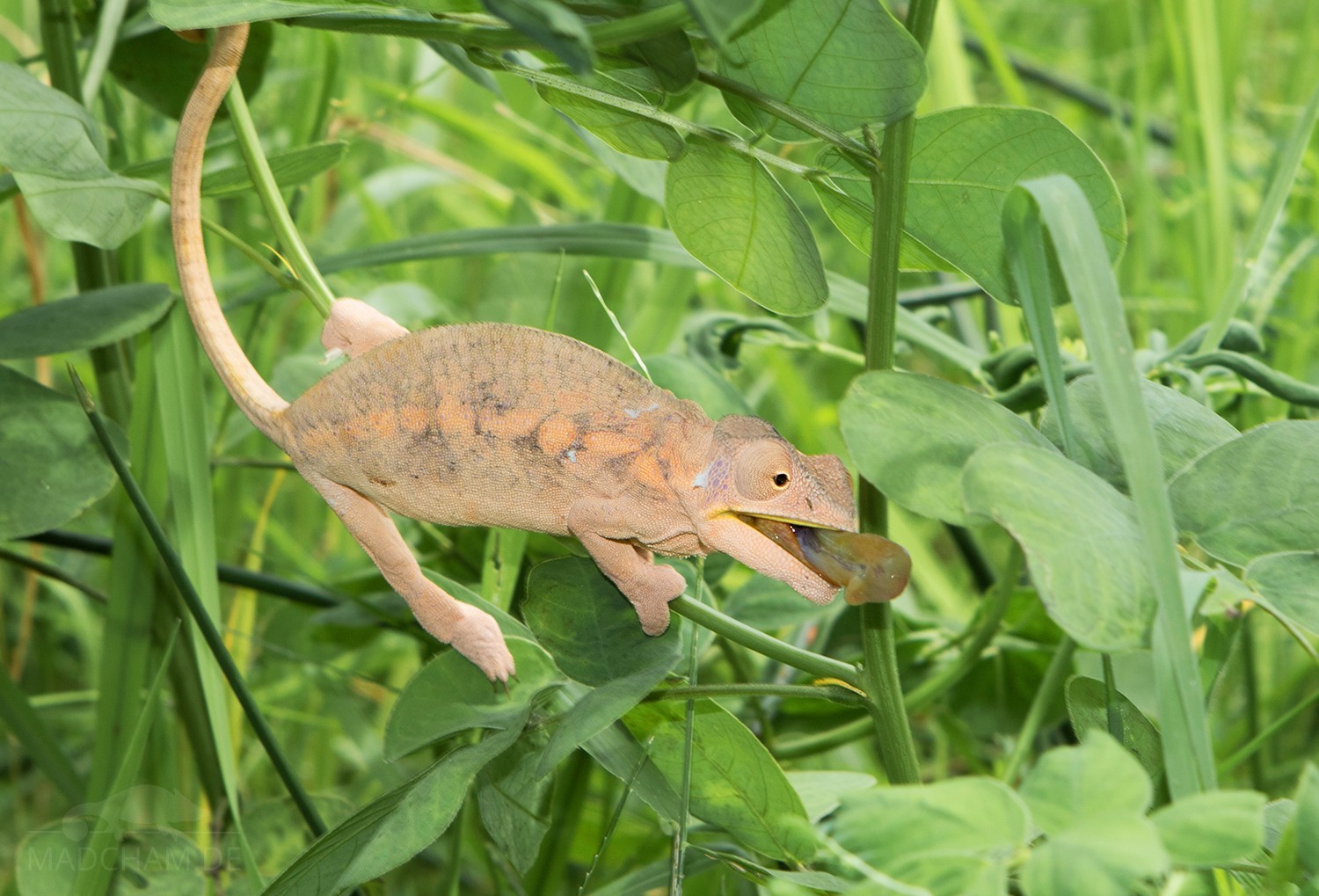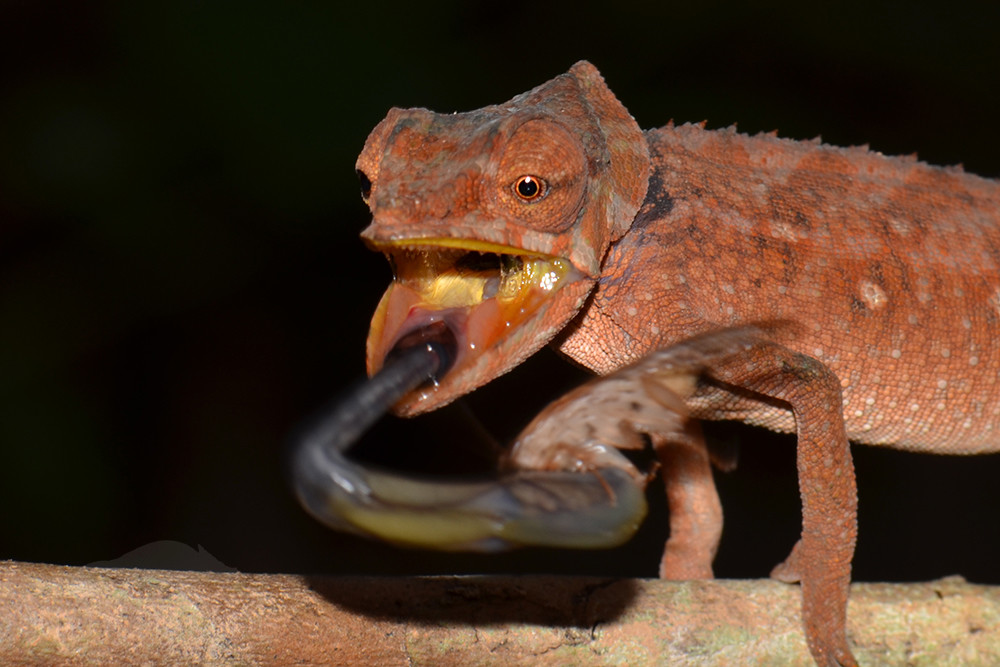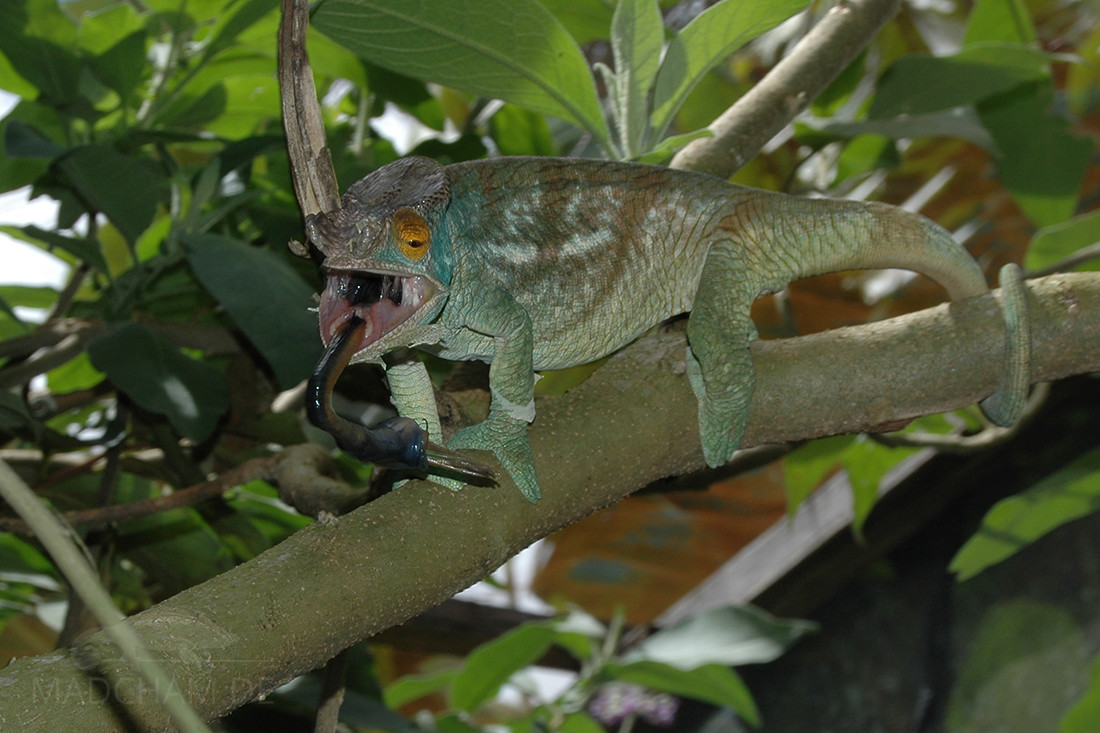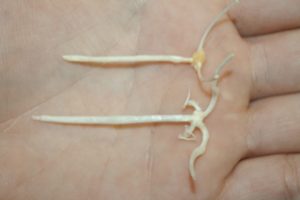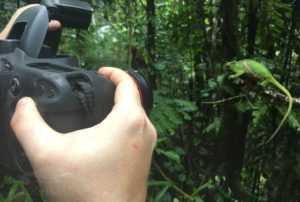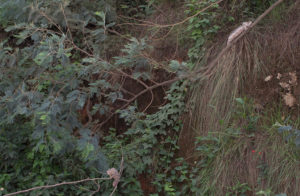The shot of the tongue is one of the characteristic features of all chameleons. This article explores the anatomy of the tongue and explains how the tongue shot works. We would like to point out that there are pictures of prepared hyoid legs and opened dead chameleons to be seen here.
Hyoid
The hyoid is the holding apparatus of the tongue, so to speak, and consists of bones and cartilage. Almost every vertebrate has a hyoid bone – including humans – but it is always differently shaped. In chameleon, the hyoid consists of the rather cartilaginous entoglossal process (3) and the two bony keratobranchial branches (1). All three meet on the so-called basihyoid, a very small spot at the entoglossal process. In front of the keratobranchial branches of the hyoid lie even smaller, soft cartilage, the keratohyal processes (2).
The tongue
The entire lingual apparatus is suspended with muscles and connective tissue between the back of the head and the lower jaw of the chameleon.
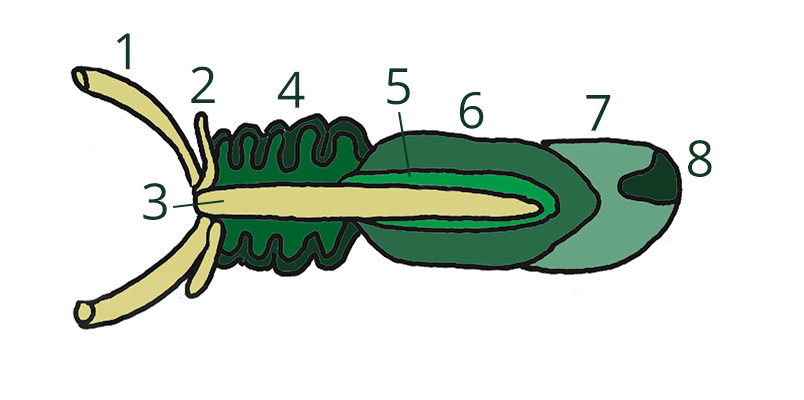
Schematic structure of the tongue
Among other things, the hyoglossus muscle (4) is important for the function of the tongue. This muscle is attached to the keratobranchial processes of the hyoid (1) and leads to the lingual accelerator muscle (6). This lies around the long entoglossal process (1) of the hyoid. For a long time, it was thought that the tongue shot was carried out with pure muscle power. Today we know that none of the tongue muscles can muster the necessary strength. So there must be another mechanism that enables the tongue to shoot. And there is! More than ten thin layers of collagen fibers (5) lie under the lingual accelerator muscle around the hyoid. They are responsible for almost all the force needed for the shot in the tongue. On the outside, this collagen fiber layer is connected to the lingual accelerator muscle, while at the back it is connected to the hyoglossal muscle.
The tip of the tongue is formed by the so-called tongue pad (7) and the tongue poach (8) located inside it. This table gives a rough overview of the muscles involved in the lingual apparatus of the chameleon.
| Muscle name | Origin | Insertion | Function |
| M. mandibulohyoideus
medialis |
Symphysis mandibulae | Basihyoid | pushes the hyoid to the front |
| M. mandibulohyoideus | lateral of Symphysis mandibulae | Spitze der keratohyalen Fortsätze | „“ |
| M. mandibulohyoideus
lateralis2 |
zwischen dem medialen und anderem lateralen Anteil des Muskels | distales Drittel der keratobranchialen Äste | „“ |
| M. omohyoideus
|
unterer Bereich der Schulter | Basihyoid wieder zur Schulter zurück | pulls the hyoid up |
| M. sternohyoideus superior | Xiphoid | Basihyoid | zieht das Basihyoid nach dem Zungenschuss zurück |
| M. sternohyoideus profundus anterior | Gewebe vor dem Xiphoid | Hintere Spitze der keratobranchialen Äste | ziehen die keratobranchialen Äste des Zungenbeins nach hinten, während Zunge schießt |
| Mm. sternohyoideus profundus posterior | Gewebe vor dem Xiphoid | Obere Hälfte der keratobranchialen Äste | |
| M. genioglossus anterior | Unterkiefer innen | Boden der Maulhöhle | bildet die Zungentasche
|
| M. genioglossus posterior | Unterkiefer innen | Kehle | |
| M. constrictor colli | Fascia nuchalis | Fascia medioventralis | verlagert Kehle nach oben |
| Mm. intermandibulares | Unterkiefer innen | Fascia medioventralis | heben das Zungenbein an |
| M. branchiohyoideus | distales Drittel der keratohyalen Fortsätze | Distales Drittel der keratobranchialen Äste | |
| M. hyoglossus | gesamte Länge der keratobranchialen Äste | Seitlich des M. accelerator linguae | zieht den M. accelerator linguae nach dem Schuss zurück auf das Zungenbein |
| M. accelerator linguae | umschließt die Zunge | Zungenpolster | hilft beim Zungenschuss |
| M. longitudinales linguae adductoris | Zungenbein | Zungenpolster | zieht einen Teil des Zungenpolster während des Schusses zurück |
| M. longitudinales linguae ventrali | M. accelerator linguae | Zungenpolster, direkt hinter den zwei Fortsätzen der Zunge | zieht die Zungenspitze während des Schusses nach unten |
| M. pulvinaris | Zungenpolster | Zungenpolster | |
| M. transversalis linguae anterior | vorderer Teil des M. accelerator linguae | Vorderer Teil der Zungentasche | |
| M. transversalis linguae posterior | hinterer Teil des M. accelerator linguae | Hinterer Teil der Zunegntasche |
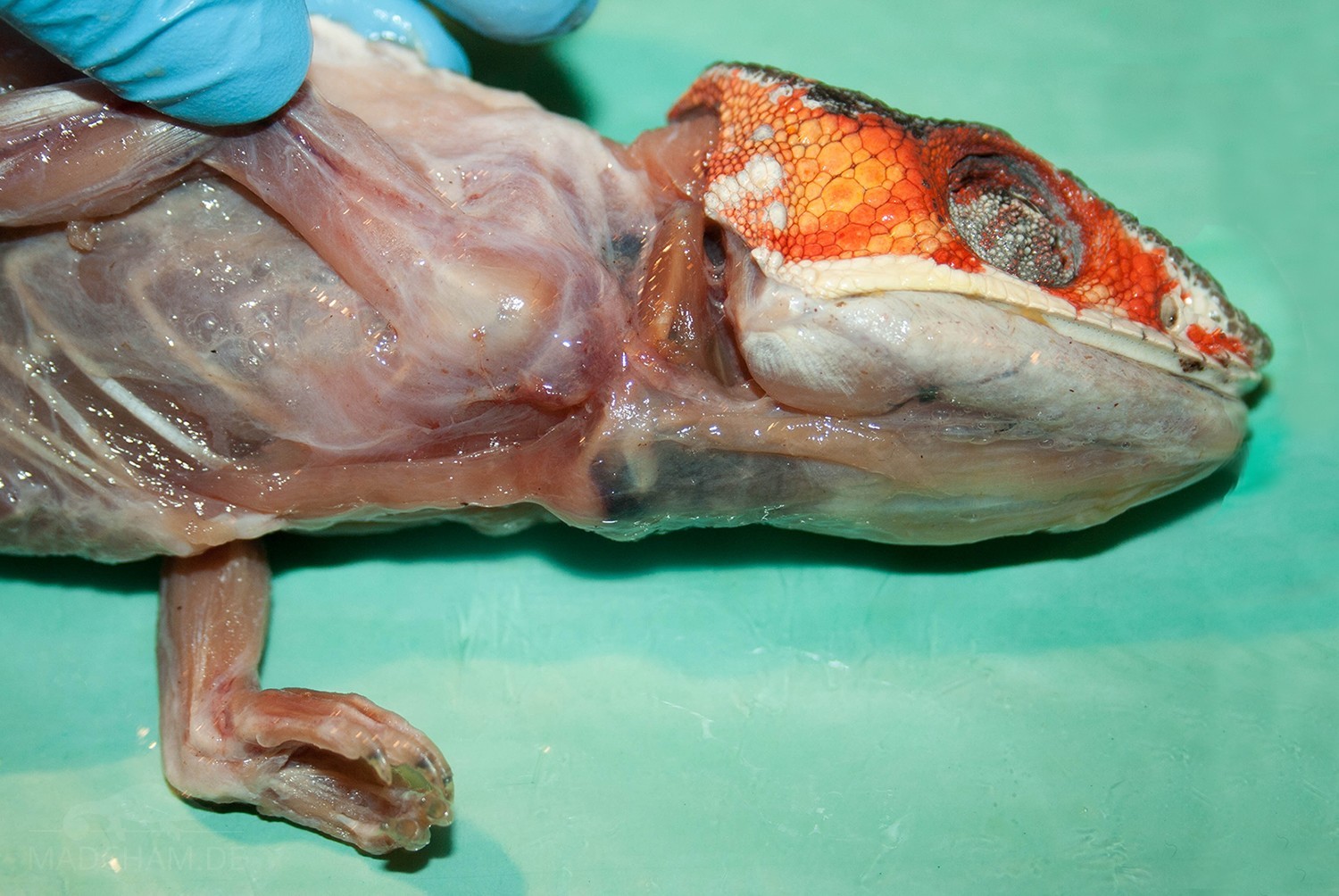
Hyoid apparatus in a panther chameleon
The tongue shooting
Chameleon prey hunting can be divided into four phases. First, the chameleon estimates the distance to the prey with its eyes and already stores the tongue a bit in front of it.
When the tongue is presented in the mouth before the shot, the lingual accelerator muscle expands the collagen fiber layer and thus loads it with potential energy. This energy is released explosively when the shot is fired. This is the second stage of the prey caught. With an acceleration of up to 486 m/sec², the Musculus accelerator linguae, including tongue pad, shoot beyond the hyoid. In doing so, the pulled hyoglossus muscle is extended to up to 600% of its original length. Put simply, the whole thing works like a kind of catapult with an elastic band.

Schematic structure of the changes in the tongue during the shooting
The extended tongue is with chameleons about one and a half body lengths long, very small species can have a tongue on even two and a half times body length. This is particularly impressive with large species such as the Parsons Chameleons: the tongue can shoot half a meter away.
At best, the tongue catches a food animal, this is the third phase. Here, chameleons make use of the so-called tongue pocket, which is formed by the genioglossus muscle and the two longitudinal linguae muscles when shot. The very viscous saliva helps to hold the prey firmly to the tongue by means of adhesion. The recoil of the “shot down” tongue, together with the hyoglossus muscle, helps to move the shot out accelerator linguae muscle and the tongue pad back into the oral cavity in the fourth phase. The tongue is relatively flaccid and the entoglossal extension of the hyoid in the mouth is clearly visible.
Depending on the species, the entire tongue shot lasts only a few tenths of a millisecond. Smaller chameleons have a larger lingual apparatus in relation to their body size and a higher acceleration when shooting the tongue than large chameleons. It is assumed that a higher shooting range can be achieved, which offers an advantage to a smaller animal in the search for food. You have to eat more than big chameleons in relation to your height.

